Post-war use of self-loading rifles and machine guns produced in Nazi Germany
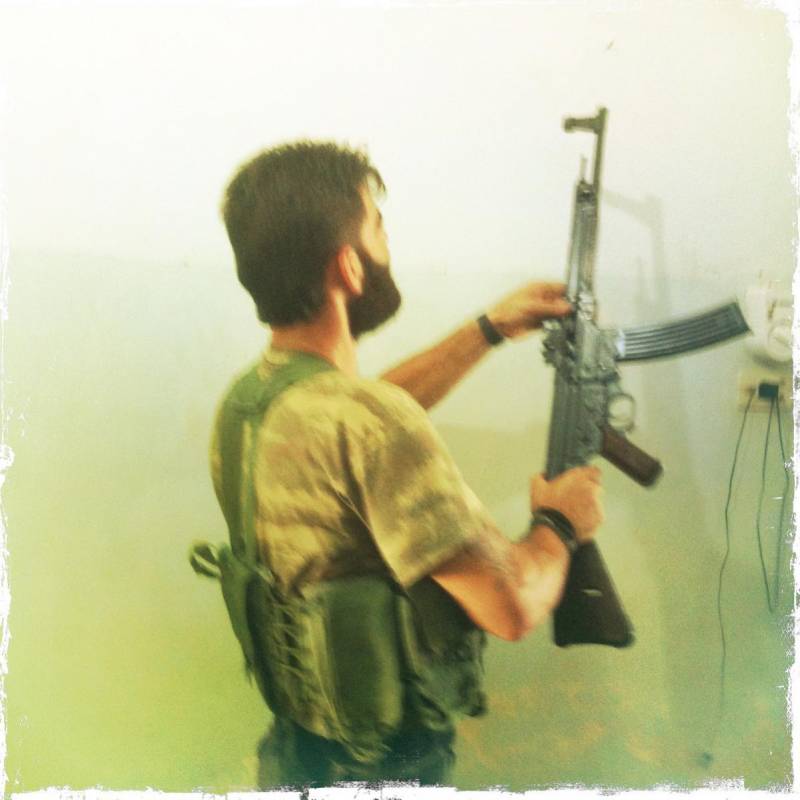
At the initial stage of the Second World War, the leadership of the armed forces of Nazi Germany did not pay due attention to self-loading and automatic rifles, although the development of such weapons conducted privately. The situation changed after it became clear that the war was dragging on, and the “machine gun hunger” that began in 1942 required the saturation of the troops with rapid-fire individual weapons that could partially compensate for the lack of machine guns.
Self-loading rifles chambered for 7,92 × 57 Mauser
As of September 1, 1939, German infantrymen were mainly armed with K98k (Mauser 98k) rifles. At that time it was one of the best repeating bolt action rifles. The Mauser product has high reliability, durability and long service life, ease and safety in handling. During World War II, K98k rifles were widely used by all branches of the German armed forces in all theaters of operations where German troops took part. However, with all its positive qualities, by the beginning of the 1940s, the K98k rifle, as an individual infantry weapon, no longer fully met the requirements. She did not have the necessary rate of fire and was a relatively bulky and heavy weapon for combat operations in populated areas. The rate of fire was limited by how fast the shooter could operate the bolt and load the 5-round magazine. However, these shortcomings were characteristic of all magazine rifles without exception. In part, the low combat rate of fire of the K98k was offset by the fact that the Germans relied not on rifles, but on single machine guns to provide firepower to the unit.
According to weapons experts, the German MG34 / 42, in terms of a set of service and operational and combat characteristics, were the most successful machine guns of the Second World War, but relying on them as the basis of the firepower of the squad was not always justified. For all their merits, these German machine guns were quite expensive and difficult to manufacture, and therefore there was always a shortage of them at the front. The use of captured machine guns captured in occupied countries and the alteration of German aviation rifle-caliber machine guns only partly made up for the lack of MG34 / 42. Submachine guns, which had high firepower, had a short firing range. Given the saturation of all branches of the armed forces with automatic weapons, it was highly desirable to arm the infantry with a rifle that surpassed the K98k in terms of rate of fire, and this problem became especially aggravated after Germany's transition to strategic defense.
At the end of 1941, two outwardly similar self-loading rifles entered the army for military trials: G41 (M) and G41 (W). The first was developed by Waffenfabrik Mauser AG, the second by Carl Walther Waffenfabrik. Rifle automation worked by removing part of the powder gases. For shooting, the same ammunition was used as in the K98k rifle.

Self-loading rifle Mauser G41
During the tests, it turned out that self-loading rifles are poorly adapted for routine service and real combat use. Both samples were sensitive to dusting. For reliable functioning of automation, their moving parts had to be thickly lubricated. After several dozen shots were fired, the sliding parts stuck together due to powder deposits, which made disassembly difficult. Burning of the flame arrester was often noted. There were complaints about being overweight and poor accuracy. Both test samples failed and were sent for revision.
In 1942, after additional tests, the Walther G41 (G41 (W)) self-loading rifle entered service. Its production was carried out at the Walther plant in Zella-Mehlis and the Berlin-Lübecker Maschinenfabrik plant in Lübeck. According to American data, more than 100 copies were made.

Self-loading rifle Walther G41
Without cartridges, the rifle weighed 4,98 kg. Length - 1138 mm. Barrel length - 564 mm. The initial speed of the bullet is 745 m / s. Combat rate of fire - 20 rounds / min. Food was supplied from an integral magazine for 10 rounds. The sights were calibrated for a distance of up to 1200 m. The effective firing range did not exceed 500 m.
Although the G41(W) rifle was officially put into service and mass production began, many of the flaws in the prototypes could not be eliminated, which caused numerous complaints from the front. In this regard, in 1943, the production of a modernized G43 rifle began. In 1944, it was renamed the Karabiner 43 (K43) carbine. On the G43, the failed gas outlet assembly was replaced with one similar to that used on the Soviet SVT-40 rifle. To reduce cost and ensure manufacturability, a significant part of the parts was made by casting and stamping, the outer surface had a very rough finish.

G43 semi-automatic rifle with 25-round magazine
Compared to the G41(W), the G43 has improved reliability, and also managed to reduce the weight to 4,33 kg and the length to 1117 mm. Food was supplied from a 10-round detachable magazine, which could be replenished with 5-round clips without removing it from the weapon. It was also possible to use a 25-round box magazine from an MG13 light machine gun. Thanks to the use of detachable magazines, the combat rate of fire increased to 30 rounds / min.
The improved G43 was produced in larger volumes than the G41(W). Until March 1945, more than 402 self-loading rifles were delivered. According to the plans of the German command, each grenadier (infantry) company of the Wehrmacht was supposed to have 000 semiautomatic devices. However, in reality, this level of equipment almost never existed.
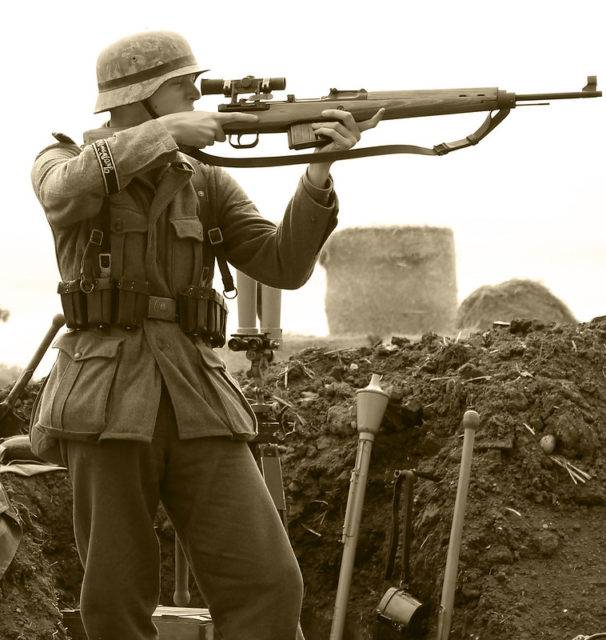
A significant part of the G43 rifles were equipped with optical sights. In terms of shooting accuracy, “sniper” self-loading rifles were significantly inferior to store-bought K98k, but in street battles, where the firing range was not great in most cases, the G43 with optics performed well.
In 1942, the Rheinmetall-Borsig company created the FG42 automatic rifle (German Fallschirmjägergewehr 42 - a paratrooper rifle of the 1942 model of the year), designed to arm airborne and mountain rifle units. It can be argued that this rifle is one of the most interesting examples of small arms designed and produced in the Third Reich.
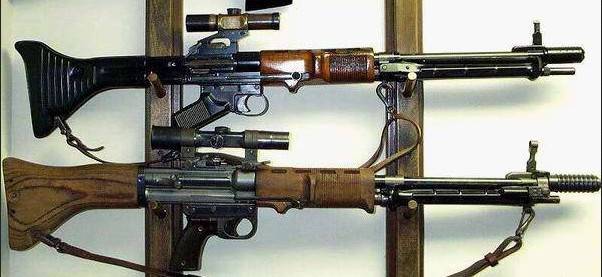
Automatic rifles FG42 / 1 and FG42 / 2
Automation FG42 functioned by removing part of the powder gases through a transverse hole in the barrel wall. The barrel bore was locked by turning the bolt, which occurs as a result of the interaction of the curved groove on the bolt and the beveled planes on the bolt carrier during the movement of the latter. Two lugs are located symmetrically in front of the bolt. The buttstock has a buffer that softens the recoil. Ammunition was fed from a box magazine with a capacity of 20 rounds, mounted on the left side of the rifle. The shock-type trigger mechanism allowed single and automatic fire.
During the operation of the first modification of the FG42 / 1, a number of shortcomings were revealed. The shooters complained about the hit of spent cartridges in the face, uncomfortable holding of the weapon, and poor stability during automatic firing. The strength and resource of some parts also left much to be desired. In addition, mass production was limited by the high cost and laboriousness of manufacturing.
Taking into account all the comments, a more technologically advanced, reliable and convenient FG42 / 2 automatic rifle was developed. In order to optimize the production process and save scarce materials, it was supposed to switch to the use of stamping from a steel sheet. However, the FG42 / 2 rifle was still very expensive to manufacture. The most difficult part to manufacture was the milled receiver, made of high-alloy steel. Due to various difficulties, Krieghoff began manufacturing a batch of 2000 rifles only at the end of 1943.
During serial production, improvements were made to the design of the FG42 aimed at reducing cost, improving ease of use and reliability. The last serial modification was the FG42 / 3 (Type G) with a stamped receiver, which nevertheless remained expensive and difficult to manufacture.
By the standards of the 1940s, the FG42 / 3 rifle had high performance and was quite reliable. The barrel and butt were on the same line, due to which there was practically no recoil shoulder, which minimized the toss of the weapon when firing. To a large extent, the return was reduced by a massive compensator-flame suppressor, mounted on the muzzle of the barrel. Sights consisted of a front sight mounted on the barrel and an adjustable rear sight placed on the receiver. A significant part of the serial FG42 was equipped with optical sights. For hand-to-hand combat, an integral four-sided needle bayonet was intended, which in the stowed position leaned back and was located parallel to the trunk; there were also folding stamped bipods.
The weight of the FG42 / 3 without cartridges was 4,9 kg. Length - 975 mm. Barrel length - 500 mm. The initial speed of the bullet is 740 m / s. The effective range with a mechanical sight is 500 m. The rate of fire is 750 rounds / min.
For a number of reasons, mass production of the FG42 was not possible in Germany. In total, about 14 copies were made. In addition to paratroopers and mountain shooters, single copies of the FG000 were at the disposal of the most experienced fighters of the Wehrmacht and the SS troops. The FG42 automatic rifle began to enter the troops too late and in small volumes, which is why it could not fully demonstrate its combat qualities and advantages.
Automatic rifles for the intermediate cartridge 7,92 × 33 mm
In the interwar period, designers and the military in different countries came to the conclusion that the existing rifle and machine gun cartridges were too powerful to solve most of the tasks inherent in individual infantry weapons. In 1940, the designers of Polte Armaturen-und-Maschinenfabrik AG, on their own initiative, created a cartridge with a dimension of 7,92 × 33 mm, which, after being put into service, received the designation 7,9 mm Kurzpatrone 43 (7,9 mm Kurz). In terms of energy, this ammunition occupied an intermediate position between the 9 mm Parabellum pistol cartridge and the 7,92 mm Mauser rifle cartridge.
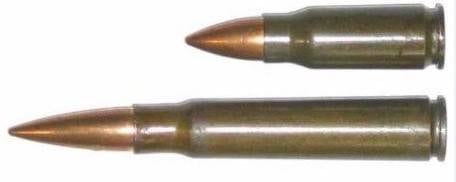
German cartridges 7,92×57 mm and 7,92×33 mm
The steel sleeve, 33 mm long, was bottle-shaped and varnished to prevent corrosion. The serial 7,9 mm Kurz SmE cartridge weighed 17,05 g. The bullet weight was 8,1 g. The muzzle energy was 1900 J. In terms of its characteristics and outwardly, the German 7,92 × 33 mm cartridge was similar to the Soviet 7,62 × 39 mm.
Under 7,9 mm Kurz in Germany, several submachine guns (assault rifles) were created and some of them were put into service.
In July 1942, an official demonstration of automatic rifles chambered for the intermediate cartridge Maschinenkarabiner 42 (H) (MKb 42 (H)) and Machinenkarabiner 42 (W) (MKb42 (W)) took place. The first was developed by CG Haenel, the second by Carl Walther Waffenfabrik. The automation of both samples was based on the principle of removing part of the powder gases.
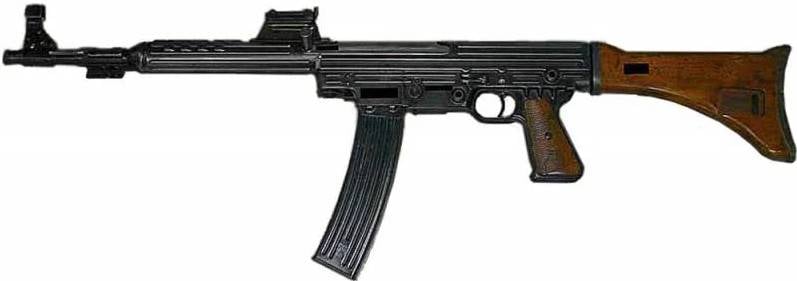
Experienced submachine gun MKb42 (W)
The winner of the competition was revealed by military tests on the Eastern Front. According to their results, subject to the elimination of a number of shortcomings and the introduction of certain changes in the design, the MKb42 (H) was recommended for adoption. The victory of this assault rifle in the competition was largely due to the fact that even at the design stage a lot of attention was paid to manufacturability and cost reduction, for which stamping was used in the manufacture of the receiver and a number of other parts.

Experienced machine gun MKb42 (H)
As changes were made to the design of the bolt, firing mechanism and gas outlet, the MP 43/1 and MP 43/2 “submachine guns” were born. In June 1943, mass production of the MP 43/1 began. The mass use of the MP43 on the Eastern Front began in the autumn of 1943. At the same time, it was found that the new machine gun combines the positive qualities of submachine guns and rifles, which makes it possible to increase the firepower of infantry units and reduces the need for light machine guns. Until December 1943, when this model was replaced by a more advanced modification at production facilities, more than 12 copies of the MP 000/43 were produced.
After receiving a positive opinion from the active army, an official decision was made to adopt a new machine gun for service. In April 1944, after the introduction of some design and technological changes, the name MP43 was replaced by MP44, and in October 1944 the weapon received its final name - StG44 (German: Sturmgewehr 44 - "Assault rifle 44").
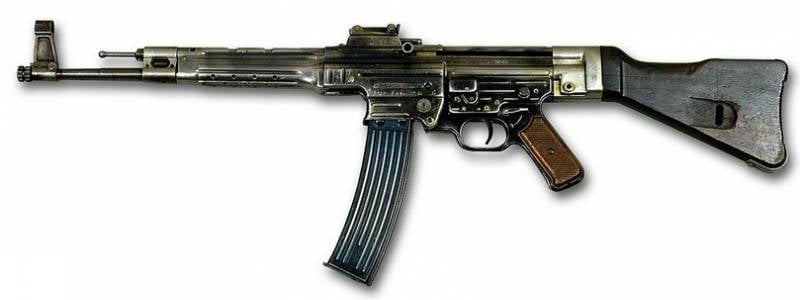
Assault rifle StG44
The weight of the StG44 without cartridges was 4,6 kg, with an attached magazine for 30 rounds - 5,2 kg. Length - 940 mm. Barrel length - 419 mm. The initial speed of the bullet is 685 m / s. The effective range of single shots is up to 400 m. The rate of fire is 550-600 rounds / min.
Various sources do not agree on the number of samples released chambered for 7,9 mm Kurz, but it can be said with certainty that during the Second World War the Germans produced more than 400 machine guns.
Mass production of automatic weapons chambered for the 7,92×33 mm cartridge was serious progress in increasing the fire capabilities of German rifle units. After eliminating most of the “childhood diseases”, German assault rifles became very good weapons. They were superior to submachine guns in terms of accuracy and firing range, bullet penetration, and had tactical versatility. At the same time, the StG44 assault rifle was quite heavy; shooters complained about the lack of a fore-end, sensitivity to moisture and dirt, and more difficult maintenance compared to the K98k. However, for the most part these were complaints from infantrymen who had previously dealt with a repeating rifle. With proper and timely care and maintenance, the StG44 assault rifle was quite reliable, which is confirmed by long-term operation in the post-war period.
The use of German self-loading rifles and machine guns in the post-war period
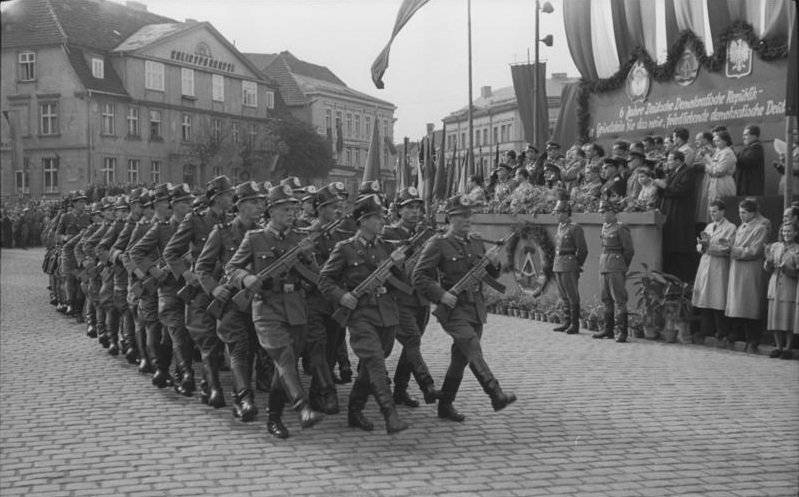
Until April 1945, the German industry managed to deliver more than 900 self-loading and automatic rifles. It is impossible to reliably establish what part of these weapons were used in the post-war period. But based on the data on the number of K000k delivered to the German armed forces, and how many of these rifles were captured, it can be assumed that approximately 98 captured self-loaders and machine guns were at the disposal of the allies in the anti-Hitler coalition.
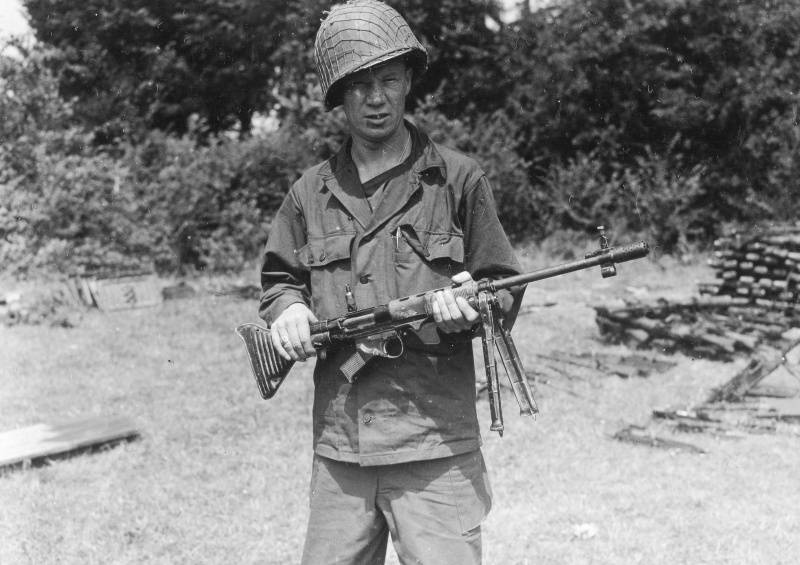
American soldier with a captured FG42 automatic rifle
It is clear that the captured weapons were in varying degrees of preservation and did not have the same prospects for further exploitation in the regular armed forces and paramilitary formations.
For example, self-loading rifles G41 (W), which had problems with reliability, were not officially used anywhere in the post-war period, although they could be at the disposal of various irregular formations.
Until the mid-43s, the improved G1960s in the GDR were in service with the barracks police, border guards and paramilitary units of the "Working Class Fighting Groups".
In addition to East Germany, 7,92-mm self-loading rifles were used as limited standard weapons in Norway, France, the Netherlands and Czechoslovakia for about a decade and a half after the war. Several thousand G43s were sold on the global arms market, and these transactions were not always legal.
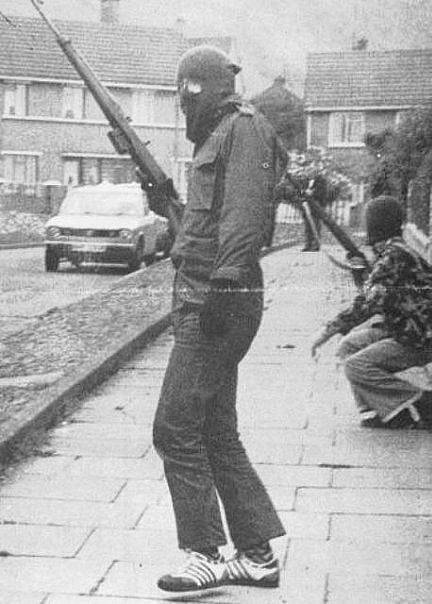
IRA fighter with a G43 rifle
A number of semi-automatic weapons produced in Nazi Germany ended up in the hands of the militants of the Irish Republican Army during the armed clashes in Ulster.
Oddly enough, German FG42 automatic rifles, produced in relatively small numbers, were used during the war in Southeast Asia.
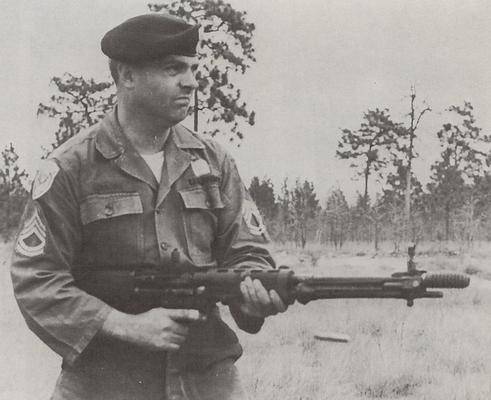
American soldier with an FG42 automatic rifle
Among the trophies of American troops in Southeast Asia, automatic rifles made in Nazi Germany were sometimes found. It is possible that they were transferred to North Vietnam from Soviet warehouses of captured small arms along with MG34 machine guns.
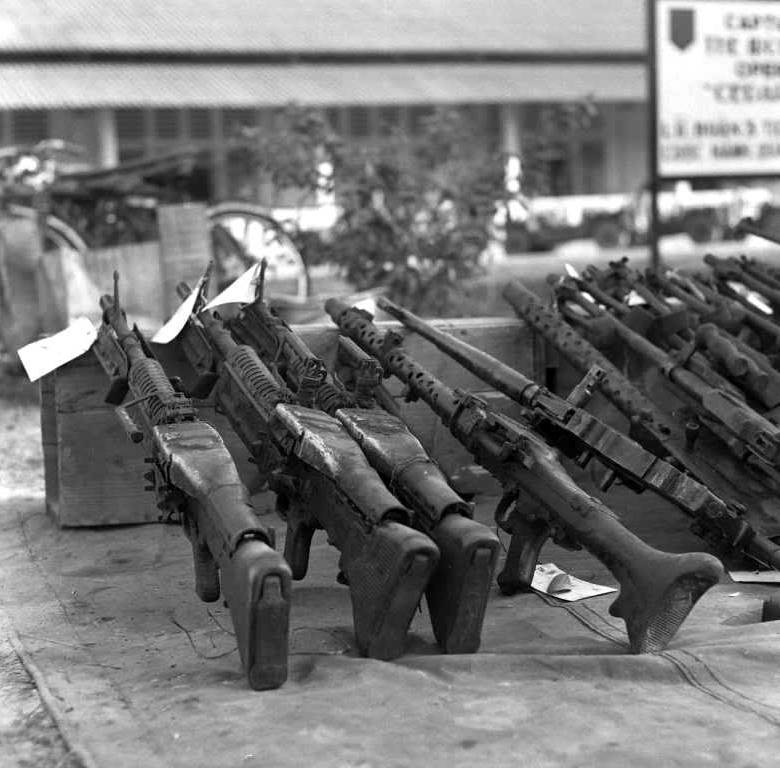
FG42 automatic rifles captured during Operation Cedar Falls, 1967
During Operation Cedar Falls, conducted from January 8 to 26, 1967, several FG42s were found in underground tunnels in an area northwest of Saigon along with other small arms.
In addition, the German automatic rifle influenced the development of American machine guns. It is believed that the gas engine of the 7,62 mm M60 machine gun was borrowed from the FG42.
German submachine guns for an intermediate cartridge were not the height of perfection, but for their time they were quite effective weapons. Despite the fact that the StG44 was often criticized for the lack of strength of stamped parts and a complex design compared to submachine guns. This weapon was actively used in a number of countries until the 1980s.
Captured machine guns were stored in the USSR until the second half of the 1950s, until the first line troops were sufficiently saturated with self-loading carbines, machine guns and light machine guns chambered for 7,62 × 39 mm.
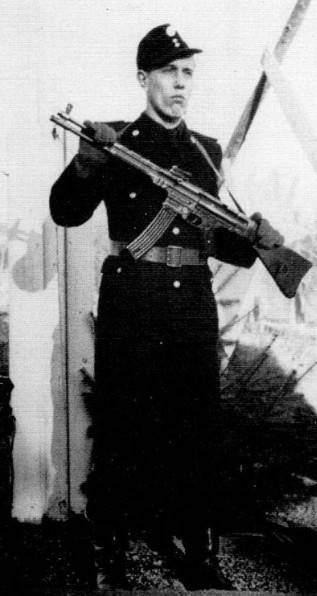
Soldier of the barracks police of the GDR with a machine gun MKb42(H)
There is also documentary evidence of the post-war use in the GDR of relatively few MKb42 (H) assault rifles.
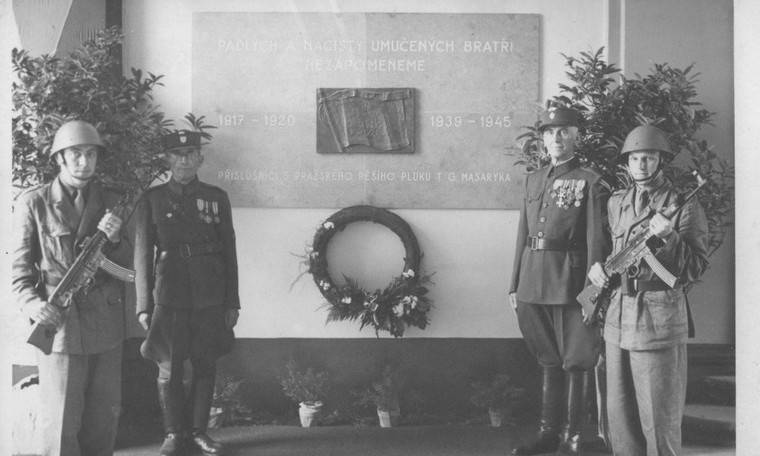
Soldiers of the Czechoslovak guard of honor, armed with machine guns StG44, 1955
In the countries of the Eastern Bloc in the late 1940s and early 1950s, StG44 assault rifles became quite widespread. In addition to the GDR, they were in service in Czechoslovakia, Hungary and Yugoslavia.
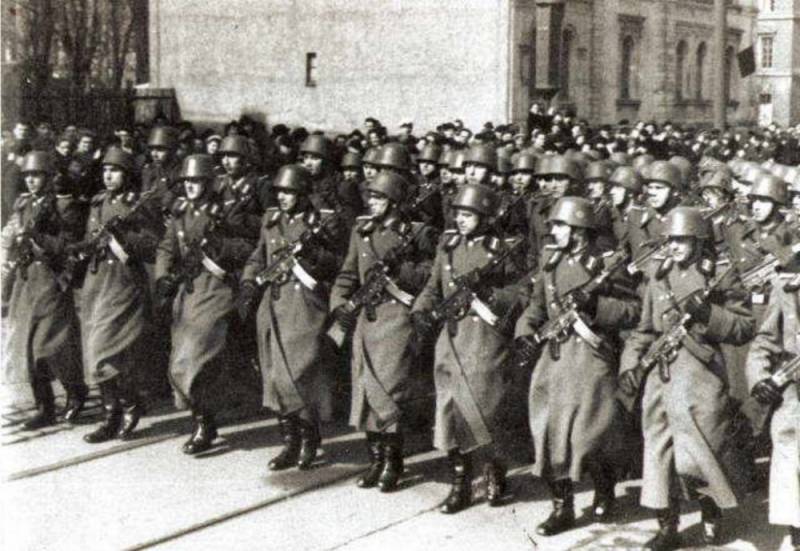
For the longest time, German-style assault rifles were operated in the Yugoslav People's Army. There are photographs taken in the 1980s showing JNA infantrymen and paratroopers armed with StG44s.
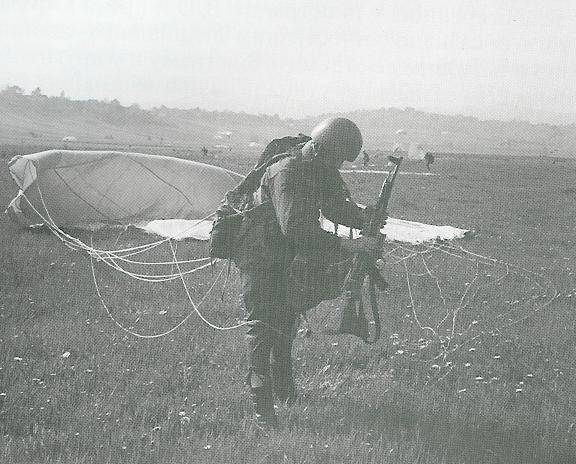
A number of reliable sources claim that in addition to the use of captured machine guns, the SFRY also produced 7,9 mm Kurz cartridges.
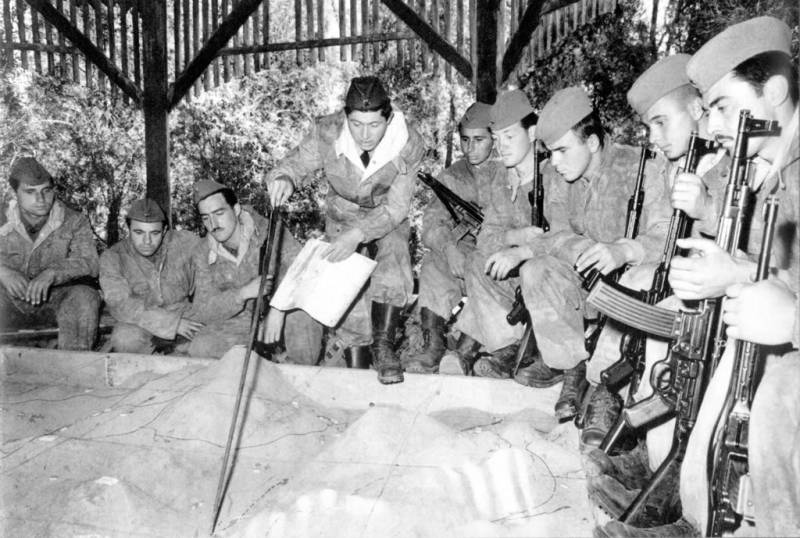
After the collapse of Yugoslavia, the StG44 assault rifles, which had been in storage since 1983, were used by various parties in ethnic conflicts.
Apparently, the first big war in which captured StG44s were used was the armed conflict on the Korean Peninsula. It was not possible to find photographs of Chinese people's volunteers or soldiers of the North Korean army armed with German machine guns, but there are StG44 in the Beijing Military Museum of the Chinese Revolution.
Western authors claim that the Soviet Union sent a small number of StG1960s to North Vietnam in the 44s. Like it or not, it is not known, but the Americans captured some StG44 in Vietnam.
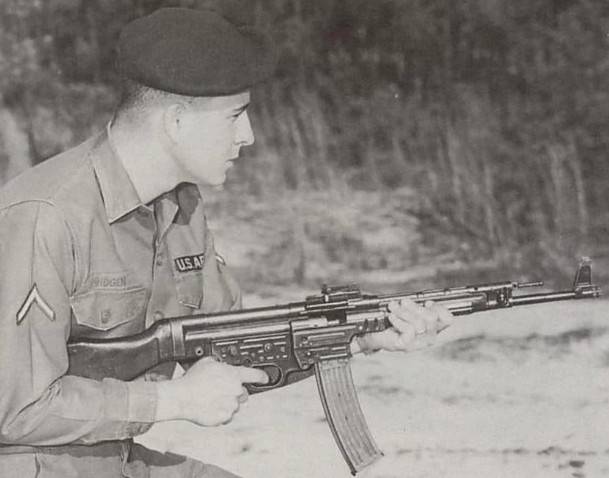
US military with StG44
The StG44 submachine guns and cartridges removed from service in the countries of "people's democracy" were sold inexpensively to African and Middle Eastern countries, and also donated to various people's liberation movements that declared a socialist orientation.

In many ways, this was convenient, since captured German weapons could not be tied to a specific supplier and the countries of the socialist camp could not be directly accused of supplying weapons to illegal formations.
According to Western estimates, in the 1950s and 1960s, more than 10 StG000s were sent to Egypt, Syria and Libya, and these machines participated in the Arab-Israeli wars and spread throughout the Middle East and Africa.
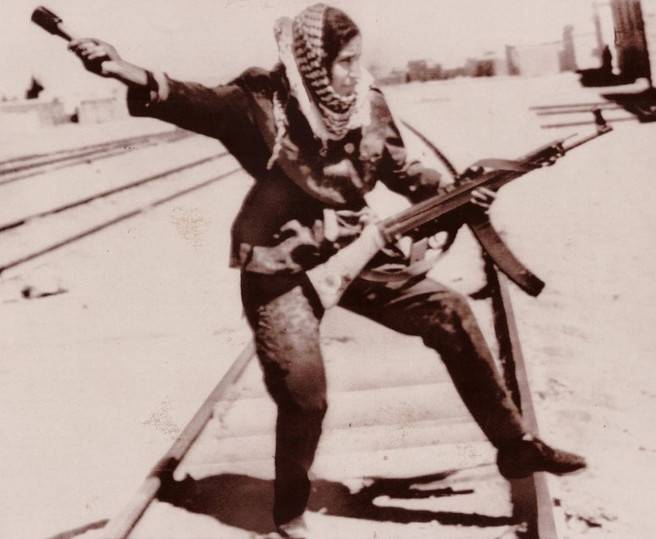
Algerian rebels had a significant number of StG44s, which they actively used against French troops.
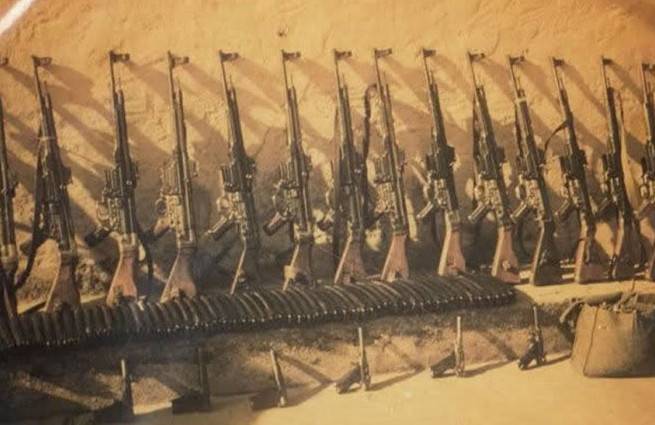
German-made assault rifles and pistols captured by the French Foreign Legion in Algiers in 1961
Thanks to the markings found on the boxes with cartridges, it was possible to establish that the StG44 and ammunition for them were delivered to Algeria from Czechoslovakia.
The next time the French encountered StG44s was in 1976 in Djibouti, when the Somali Coast Liberation Front troops invaded this country.
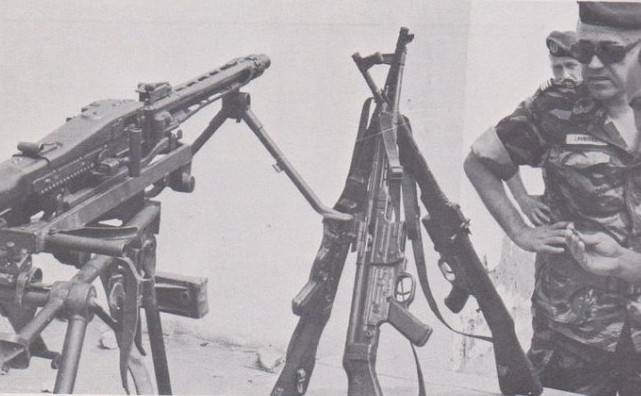
MG42 machine gun and StG44 assault rifles captured by French gendarmes in Djibouti in 1976
After the start of the civil war in Syria, a significant part of the weapons depots in this country was looted, and the StG44s that were in storage were at the disposal of the armed opposition.

It is not known how often and effectively the old German machine guns were used in combat, but the Islamists posed with them very willingly.

After the Americans invaded Iraq in 2003, weapons confiscated from Saddam's Fedayeen included StG44s.
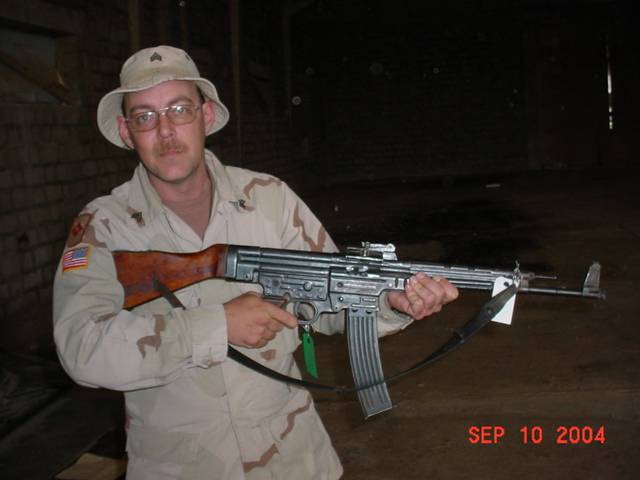
According to Western estimates, Libya received over 1000 StG44s from Yugoslavia. In 2013, former Libyan machine guns surfaced in the underdeveloped and politically unstable West African country of Burkina Faso (formerly Upper Volta), which is regularly rocked by military coups. The StG44s that ended up in Burkina Faso are believed to have come from Libyan warehouses looted during the civil war and traveled south via Saharan nomads who view small arms as a means of payment or a commodity.
Finishing the story about StG44, one cannot fail to mention his roles in the cinema. In addition to feature films dedicated to the Second World War, the bourgeois attacked with this machine gun in the Soviet feature film "The Tale of Malchish-Kibalchish", filmed at the A. Dovzhenko Film Studio in 1964.

And the American actress of German origin Elke Sommer, who starred in the 44 parody action movie "More Merciless than Men", looks absolutely amazing with the StG1967.
Продолжение следует ...
Information